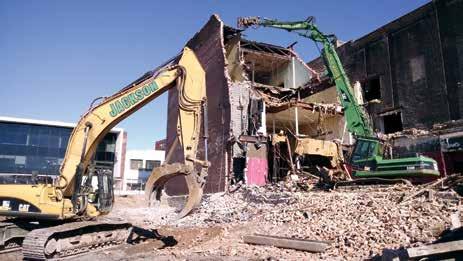
6 minute read
Risk-tolerant or Control-Deprived?
By dave rebbitt
Risk is not something we can do away with entirely. the first and easiest way to manage risk is to transfer the risk to someone else. this can take the form of insurance or subcontractor. Insurance would transfer some of the risks, but getting someone else to perform the work can transfer the risk entirely. If the company undertakes the work or operation, then it can use the second method, which is to mitigate the risk using a standard methodology.
Interestingly enough, the type of risk does not matter all that much. financial and operational risk can be identified and mitigated in much the same way as what we often term safety risk. these two ways to manage risk are the most common and most widely discussed. however, there is a third way in which corporations manage risk. they accept it. this is often called residual risk or acceptable risk. this is where we see the term risk tolerance used. how much risk will a company or workplace accept?
In terms of insurance, it means setting the deductible on the policy along with the upper limits. We do much the same with car insurance. the cost for the insurance is based on the probability of you having an incident based on research by insurance companies, but another function of the cost is the deductible. a high deductible will get you a much cheaper policy. the insurance rate will vary on your performance just as it does for a company, whether that is property insurance or workers’ compensation insurance rates.
When it comes to safety, the impression often is that there is no acceptable risk, but that is not right. Decisions are made every day to accept risk. So when it comes to risk tolerance, the question often is, “Do we understand the risk?”
Risk is a function of the frequency of exposure, probability of an incident and potential severity of the outcome. We recognize hazards and assess the risk using these criteria. any high-rated risks will get dealt with first. But as we work down the scale, when does a risk become acceptable? that

depends on the organization and its risk tolerance.
On an individual level, there also is risk tolerance. Workers are very good at spotting hazards. Most incidents are not all that surprising to the workers in the area, as they knew the hazard existed. Some may say they just thought the risk was acceptable.
Maybe we are overthinking this a little.
In safety, the risk is mitigated using the hierarchy of controls. It has been around a

James Jordan Associates
Architects
Educational, Commercial and Institutional Facilities
68 Main Street PO Box 111 Richfield Springs, NY 13439
(315) 858-8000 JORDANUSA.COM long time and almost anyone in the safety profession knows what it is: • Elimination. Most effective. • Substitution. using a different method, process or products. • Engineering. Design out the hazard or separate it from workers. • Administrative. Procedures, policies or checklists.
• Personal protective equipment (PPE).
Least effective.
Many people who have been to a construction site will be familiar with the belief that “be careful” is an effective control. Many personal or group hazard assessments contain this phrase as do many the job hazard analysis. So, is using “be careful” demonstrating that workers have a high-risk tolerance or just that they have no clear idea of how to control those hazards?
Workers do their job in the workplace provided by their employers. the employer is charged with keeping them safe and determining what controls are required to mitigate known hazards. the only tangible portion of that process for the employee is the PPE the employer requires them to wear. Workers have some control over the final and most ineffective of all the controls (PPE) but not the others; those are controlled by the employer. how many companies have a process for workers to suggest or request engineering controls or administrative controls? What about substitution or elimination? as we move up the hierarchy, the time and resources required to implement those controls also tend to rise. have we left our workers with only two choices: “be careful” or PPE? a good example is the one you would see on any construction or industrial site. Workers must move across uneven ground. assuming that there is adequate lighting, what must a worker do to mitigate this hazard? the outcome could be a fall or a twisted ankle, but the company has deemed the risk acceptable. this is where

we often see “be careful” listed as the control.
More appropriately, we would use a hazard reporting process if the ground became very uneven or slippery to ensure action was taken. Still, the most effective control is for the worker to wear boots with six-inch uppers to provide ankle support (they must be laced up and tied, of course) to mitigate the hazard, as we know it is inevitable a worker will roll their foot and possibly twist their ankle. now, many safety people reading this are thinking they would never do that. Well, when incidents are investigated, the most common corrective actions usually revolve around training or retraining and PPE. Other action items are to follow existing processes or to continue to be more careful. this is hardly a practical approach. a recent article in the february issue of Professional Safety found that higher-order controls seldom are recommended in incident investigations. When looking to mitigate risk, we must start at the top of the hierarchy and work our way down.
Safety personnel can be under pressure to show quick results or quick action after an incident. PPE is quickly available and distributed. Retraining ensures the worker is trained but implies the training was ineffective the first time or the supervisor was ineffective; perhaps both may apply. Engineering out a problem can be both costly and time-consuming.
If we are frustrated by workers who think “being careful” is what it takes to keep them safe, does that mean they must live in fear of an incident? It seems they are not highly risk-tolerant but perhaps lack access to the control mechanisms and methodology. If there is no way for workers to influence the control methods or risk mitigation in the workplace more directly, that probably means we only have left them with PPE and “being careful.”
Branding workers as having a high-risk tolerance is over complicating things. they are great at identifying the hazards but are in the dark about the hierarchy of controls. are we giving them the knowledge and means to reduce risk or just asking them to be careful — and wear that PPE?
Reprinted with permission from the August 2020 edition of the Ironworker, the official publication of the International Association of Bridge, Structural, Ornamental and Reinforcing Iron Workers (www.ironworkers. org).
ABOuT DAve ReBBITT
Dave Rebbitt is a long-practicing safety professional with over 30 years of experience. he is an advocate for intelligent safety and the most published author, on safety, in Canada, recently publishing the book, Effective Safety Committees. he also sits on the Board of Governors for the Board of Canadian Registered Safety Professional and is a past board member of the alberta WCB. he is currently president and owner of Rarebit Consulting, a safety and management consulting firm. b


• Demolition & Dismantling • Asset Recovery • Abatement & Hazardous
Materials Abatement • Recycling • Environmental Remediation & Site Restoration
397 Anthony Street Schenectady, NY 12308
518-374-3366
info@jacksondemolition.com jacksondemolition.com






